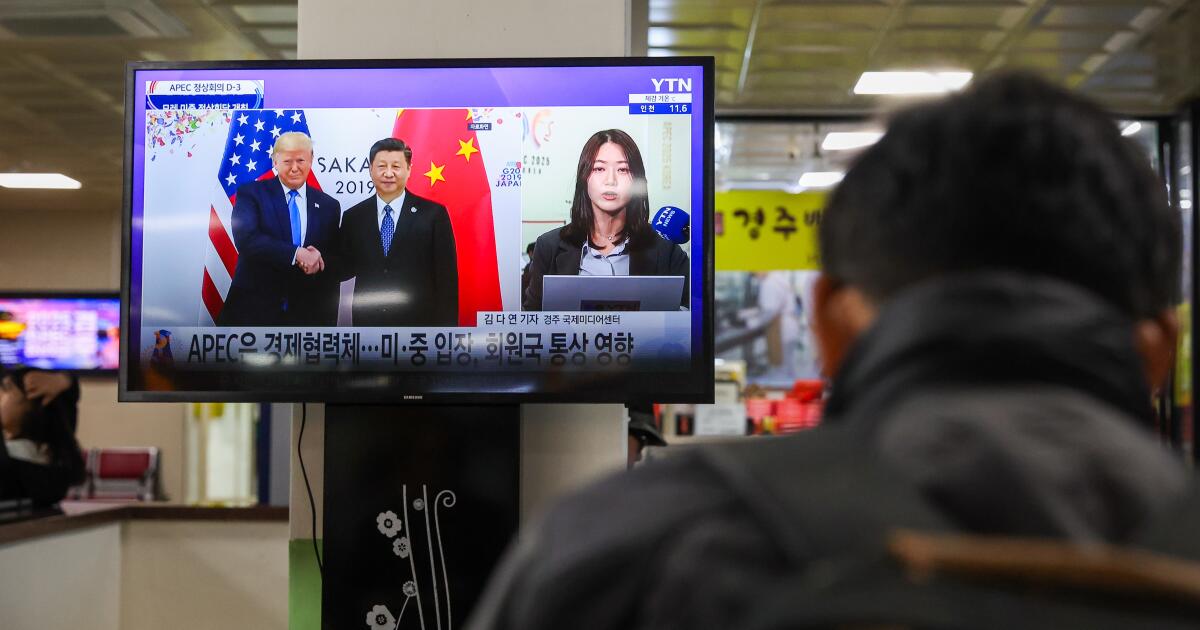Analysis: Trade deal or truce? Questions as Trump meets with China’s Xi
WASHINGTON — President Trump faces the most important international meeting of his second term so far on Thursday: face-to-face negotiations with Xi Jinping, who has made China a formidable economic and military challenger to the United States.
The two presidents face a vast agenda during their meeting in Seoul, beginning with the two countries’ escalating trade war over tariffs and high-tech exports. The list also includes U.S. demands for a Chinese crackdown on fentanyl, China’s aid to Russia in its war with Ukraine, the future of Taiwan and China’s growing nuclear arsenal.
Trump has already promised, characteristically, that the meeting will be a major success.
“It’s going to be fantastic for both countries, and it’s going to be fantastic for the entire world,” he said last week.
But it isn’t yet clear that the summit’s concrete results will measure up to that high standard.
Treasury Secretary Scott Bessent said Sunday that the two sides have agreed to a “framework” under which China would delay implementing tight controls on rare earth elements, minerals crucial for the production of high-tech products from smartphones and electric vehicles to military aircraft and missiles. He said China has also agreed to resume buying soybeans from U.S. farmers and to crack down on fentanyl components.
In return, Bessent said, the United States will back down from its stinging tariffs on Chinese goods.
Nicholas Burns, the U.S. ambassador in Beijing under then-President Biden, said that kind of deal would amount to “an uneasy trade truce rather than a comprehensive trade deal.”
“That may be the best we can expect,” he said in an interview Monday. Still, he added, “it will be a positive step to stabilize world markets and allow the continuation of U.S.-China trade for the time being.”
But U.S. and Chinese officials have been close-mouthed on what, if anything, has been agreed on regarding Xi’s other big trade demand: easier U.S. restrictions on high-tech exports to China, especially advanced semiconductor chips used for artificial intelligence.
Burns said the two superpowers’ technology competition is “the most sensitive … in terms of where this relationship will head, which country will emerge more powerful.”
Giving China easy access to advanced semiconductors “would only help [the Chinese army] in its competition with the U.S. military for power in the Indo-Pacific,” he warned.
Other former officials and China hawks outside the administration have said, even more pointedly, that they worry that Trump may be too willing to trade long-term technology assets for short-term trade deals.
In August, Trump eased export controls to allow Nvidia, the world leader in AI chips, to sell more semiconductors to China — in an unusual deal under which the U.S. company would pay 15% of its revenue from the sales to the U.S. Treasury.
Matthew Pottinger, Trump’s top China advisor in his first term, protested in a recent podcast interview that the deal risked trading a strategic technology advantage “for $20 billion and Nvidia’s bottom line.”
Underlying the controversy over technology, some China watchers warn, is a basic mismatch between the two presidents: Trump is focused almost entirely on trade and commercial deals, while Xi is focused on displacing the United States as the biggest economic and military power in Asia.
“I don’t think the administration has a strategy toward China,” said Bonnie Glaser, a China expert at the German Marshall Fund of the United States. “It has a trade strategy, not a China strategy.”
“The administration does not seem to be focused on competition with China,” said Jonathan Czin, a former CIA analyst now at Washington’s Brookings Institution. “It’s focused on deal making. … It’s tactics without strategy.”
“We’ve fallen into a kind of trade and technology myopia,” he added. “We’re not talking about issues like China’s coercion [of smaller countries] in the South China Sea. … China doesn’t want to have that bigger, broader conversation.”
It isn’t clear that Trump and Xi will have either the time or inclination to talk in detail about anything other than trade.
And even on the front-burner economic issues, this week’s ceasefire is unlikely to produce a permanent peace.
“As with all such agreements, the devil will be in the details,” Burns, the former ambassador, said. “The two countries will remain fierce trade rivals. Expect friction ahead and further trade duels well into 2026.”
“Buckle up,” Czin said. “There are likely more sudden moves from Beijing ahead.”
In the long run, Trump’s legacy in U.S.-China relations will rest not only on trade deals but on the larger competition for economic and military power in the Pacific Rim. No matter how this week’s meetings go, those challenges still lie ahead.

